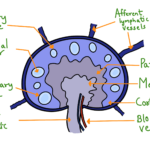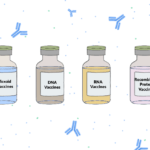In near future, children can be immunized/vaccinated by chewing food instead of administering injections shots. HOW? By using Edible Vaccines.
As explained in our previous articles, vaccines are biological preparations introduced in body to improve the immunity against a particular disease by recognizing the antigen. But there are side effects like if vaccine not completely inactivated that can be threatening, then there are problems regarding transport, cold storage, expert healthcare personnel required for administration. To overcome this risk, an alternate vaccine delivery system was proposed known as “Edible vaccines”. These are the vaccines produced by transgenic plants or animals by inserting the protein of interest (viral or bacterial protein) into their genome and producing an antigen without harming its immunogenicity.
Thus, edible vaccines are cost-effective, easy to administer, easy storage and fail-safe.
History
In 1989, Hiatt and co-workers made an effort to formulate plant-based vaccine. In 1990, Dr.Arntzen introduced the idea of using transgenic plants to produce and deliver subunit vaccines. The milestone in edible vaccine production was expression of surface antigen from hepatitis B in tobacco plant by Mason et al. Parallelly, production of hepatitis B and heat-liable toxin B in potato and potato plants was carried out as edible vaccines.
| Edible vaccine | Disease | Antigen selected | Plant system used | Research Group |
| Hepatitis | Hepatitis B | Surface antigen (HBAg) | Tobacco | Mason et al., 1992 |
| E.coli | Diarrhea | Heat-liable toxin B subunit (LTB) | Potato tuber/ tobacco leaf | Haq et al., 1995 |
| Rabies virus | Rabies | Rabies virus glycoprotein (RVG) | Tomato leaf /fruit | McGarvey et al., 1995 |
| Norwalk Virus | Gastroenterities | Norwalk virus capsid protein (NVCP) | Potato tuber/ tobacco leaf | Mason et al., 1996 |
| Vibrio cholerae | Cholerae | Cholera toxin B subunit (CBT) | Tobacco leaf | Hein et al., 1996 |
Mode of action
The normal vaccines target systemic immunity while edible vaccines affect systemic as well as mucosal immunity. The mucosal immunity is the first line of defense of the body which includes both innate and adaptive (T and B cells) arms. After oral administration of vaccine, it follows the following path.
The edible vaccine is ingested, it is masticated and degraded in intestine’s Payer’s patches. Payer’s patches are rich source of IgA producing plasma cells. It contains 30-40 lymphoid nodules containing follicles for development of germinal center. The antigen penetrates the follicles and accumulate in lymphoid structure. Then antigen comes in contact with M(Microfold)-cells which express MHC II molecules. M cells pass these antigens to macrophage and B-cells within the lymphoid follicle. Macrophage display pieces of the antigen to helper T-cells. T cells stimulate B-cells and seek out antigens at distant sites. Activated B-cells leaves lymphoid follicle and reaches mucosal associated lymphoid tissue (MALT). In MALT plasma cells are differentiated from B-cells. Then antibodies are produced against IgA. These same IgA antibodies are diverted to the lumen in secretions across epithelial cells to interact with antibodies. Thus, T and B cells will facilitate long-lasting memory cells for subsequent actual infection.

Production of Edible vaccine
Edible vaccine is produced by incorporation of transgene into the selected plant cell. The transgene is integrated with vector and delivered using direct gene delivery methods like biolistic gene gun bombardment method, electroporation or by indirect gene delivery method into the plant system by agrobacterium mediated gene transfer.
The general procedure can be:
We cut a leaf as explant and expose the leaf to bacterial suspension carrying an antigen gene and an antibiotic resistant gene. The gene in vector is transferred to plant cell and inserted into its genome by direct or indirect gene transfer method. The explant grows into callus. Then the callus culture is transferred to plate containing antibiotic. Thus, callus cells in which transfer of gene of interest is successful will survive, while untransformed cells will die. Let these surviving cells multiply and form shoots and roots. Then, put the plantlet into soil to grow into plant bearing edible vaccine.

Major plant species used as vaccine model
Potato: tetanus, diphtheria, hepatitis B and Norwalk virus
Rice: hepatitis B
Banana: hepatitis B
Tomato: acute respiratory syndrome, SARS, Norwalk virus, pneumonia, septicaemia and bubonic plagues
Lettuce: enteric diseases, hepatitis B
Tobacco: Norwalk virus, chicken infectious anemia, hepatitis B, coccidiosis
Alfalfa: hog pest virus
Carrots: HIV, E. coli, Helicobacter pylori
Other systems used to produce edible vaccines
Algal based edible vaccines
Insect cell-based vaccines
Whole-cell yeast-based vaccines
Lactic acid bacteria-based vaccine
Challenges
- Not accepted by the some public with opinion that it is a genetically modified product that can harm environment as well as society.
- Close monitoring required when plant is growing, to avoid cross-contamination in molecular farming between genetically modified plants and non-genetically modified crops.
- Plant parts like tobacco in which vaccine is produced cannot be consumed, while rice and potato cannot be consumed raw. Thus, such aspects need alternative in upcoming future.
- Recurrent delivery of plant made edible vaccine can boost regulatory T-cell stimulation which can cause hypersensitive reactions
- It is difficult to administer controlled dosage of vaccine due to biological variations in plant system .
- Variation in dosage due to age of person.
But, edible vaccines can overcome these side effects and disadvantages and can bring control over infectious diseases at cheaper cost and no side-effects.



